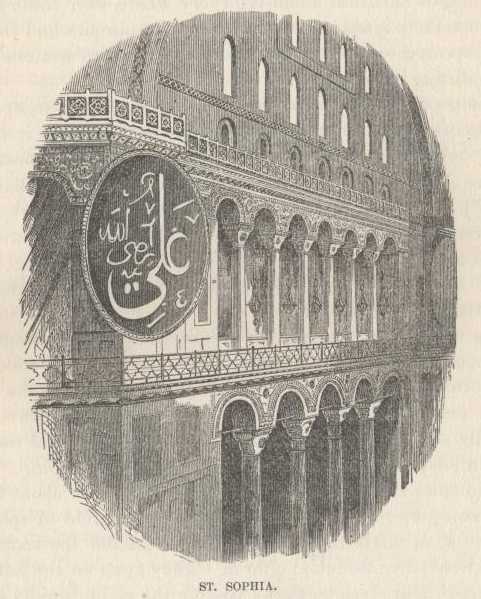The Mosque of St. Sophia is the chief lion of Constantinople. You must get a firman and hurry there the first thing. We did that. We did not get a firman, but we took along four or five francs apiece, which is much the same thing.
I do not think much of the Mosque of St. Sophia. I suppose I lack appreciation. We will let it go at that. It is the rustiest old barn in heathendom. I believe all the interest that attaches to it comes from the fact that it was built for a Christian church and then turned into a mosque, without much alteration, by the Mohammedan conquerors of the land. They made me take off my boots and walk into the place in my stocking-feet. I caught cold, and got myself so stuck up with a complication of gums, slime and general corruption, that I wore out more than two thousand pair of boot-jacks getting my boots off that night, and even then some Christian hide peeled off with them. I abate not a single boot-jack.

St. Sophia is a colossal church, thirteen or fourteen hundred years old, and unsightly enough to be very, very much older. Its immense dome is said to be more wonderful than St. Peter’s, but its dirt is much more wonderful than its dome, though they never mention it. The church has a hundred and seventy pillars in it, each a single piece, and all of costly marbles of various kinds, but they came from ancient temples at Baalbec, Heliopolis, Athens and Ephesus, and are battered, ugly and repulsive. They were a thousand years old when this church was new, and then the contrast must have been ghastly—if Justinian’s architects did not trim them any. The inside of the dome is figured all over with a monstrous inscription in Turkish characters, wrought in gold mosaic, that looks as glaring as a circus bill; the pavements and the marble balustrades are all battered and dirty; the perspective is marred every where by a web of ropes that depend from the dizzy height of the dome, and suspend countless dingy, coarse oil lamps, and ostrich-eggs, six or seven feet above the floor. Squatting and sitting in groups, here and there and far and near, were ragged Turks reading books, hearing sermons, or receiving lessons like children. And in fifty places were more of the same sort bowing and straightening up, bowing again and getting down to kiss the earth, muttering prayers the while, and keeping up their gymnastics till they ought to have been tired, if they were not.
Every where was dirt, and dust, and dinginess, and gloom; every where were signs of a hoary antiquity, but with nothing touching or beautiful about it; every where were those groups of fantastic pagans; overhead the gaudy mosaics and the web of lamp-ropes—nowhere was there any thing to win one’s love or challenge his admiration.
The people who go into ecstasies over St. Sophia must surely get them out of the guide-book (where every church is spoken of as being “considered by good judges to be the most marvelous structure, in many respects, that the world has ever seen.”) Or else they are those old connoisseurs from the wilds of New Jersey who laboriously learn the difference between a fresco and a fire-plug and from that day forward feel privileged to void their critical bathos on painting, sculpture and architecture forever more.